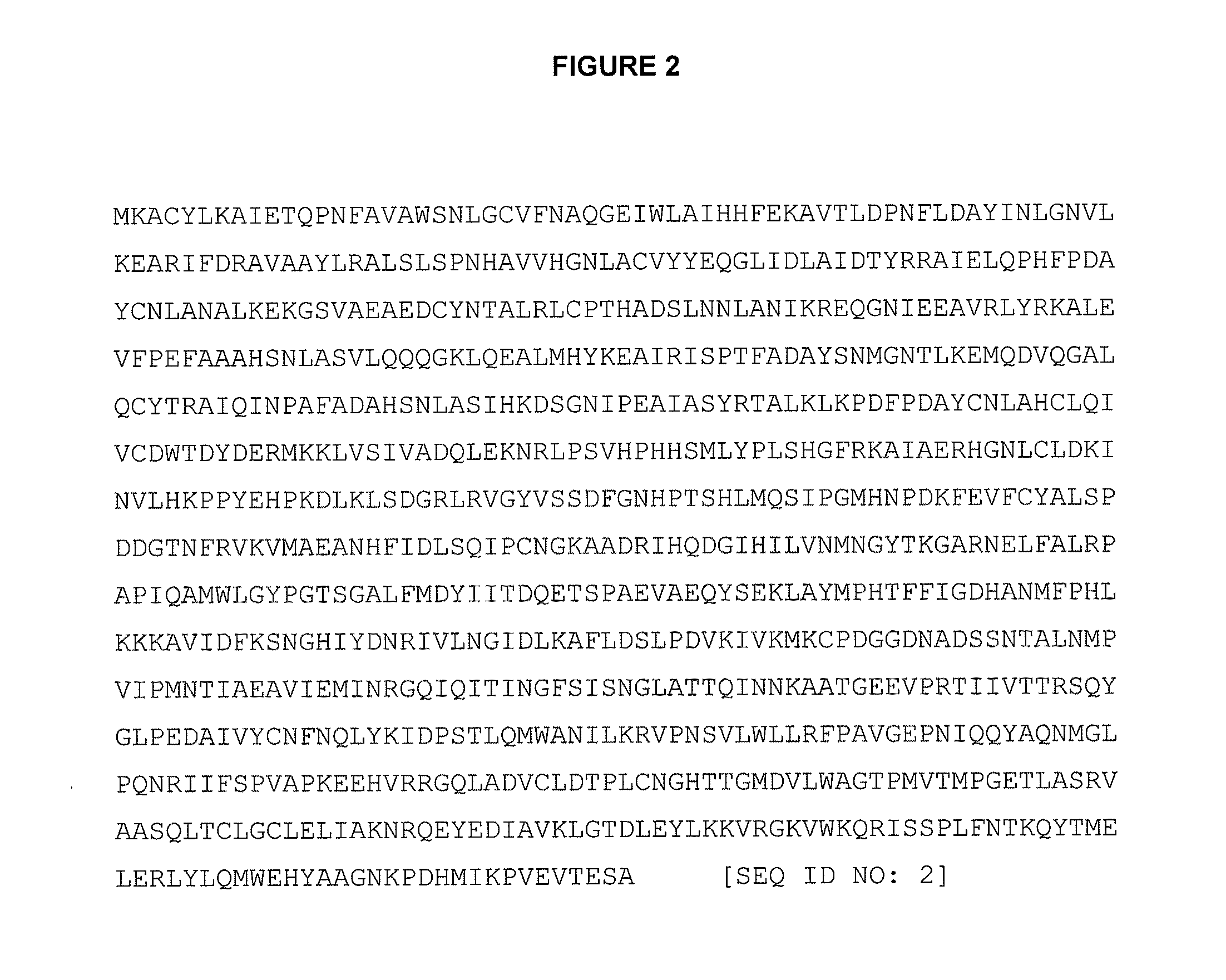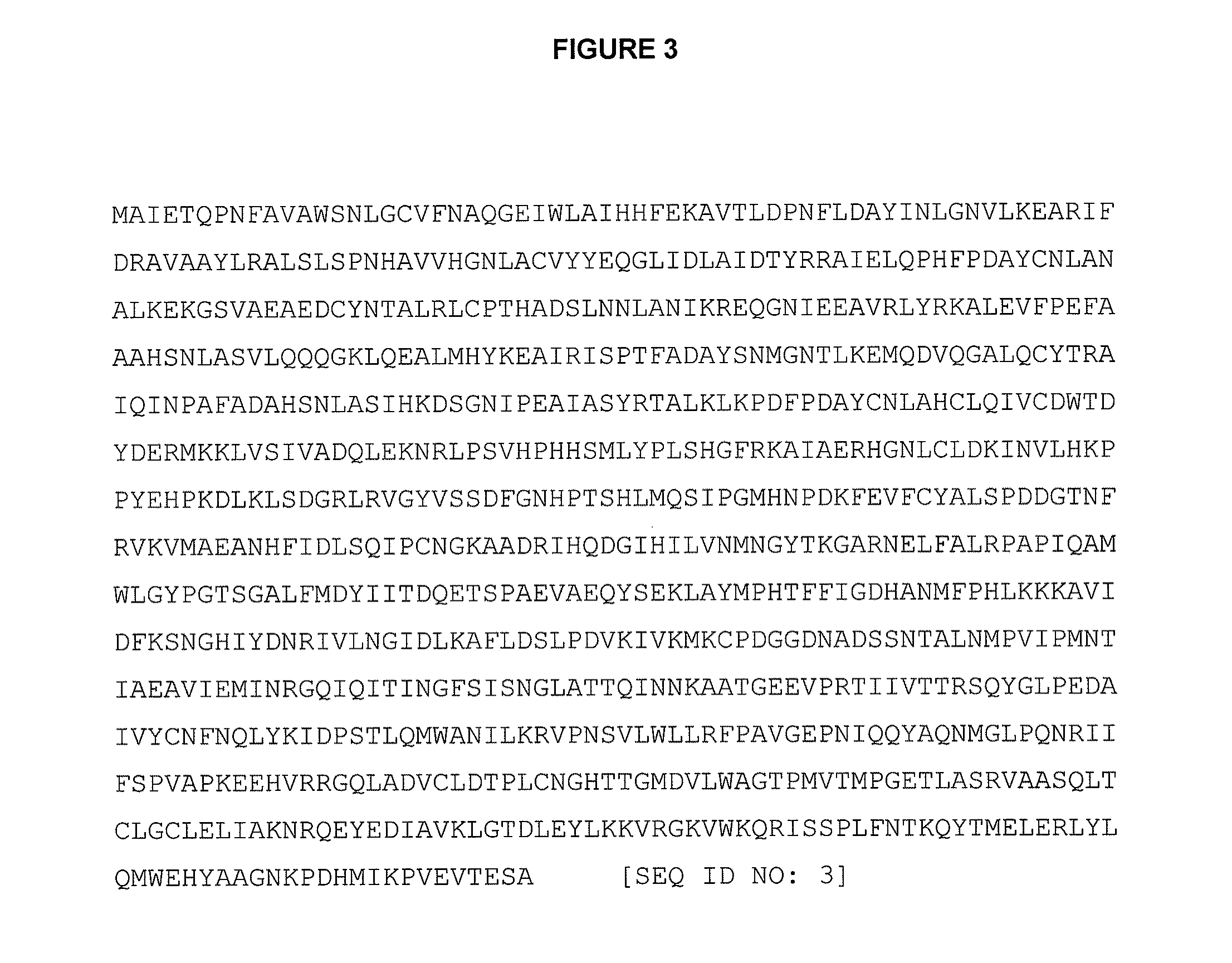O-linked glycosylation using n-acetylglucosaminyl transferases
a glycosylation and acetylglucosaminyl transferase technology, applied in the direction of depsipeptides, peptide/protein ingredients, fusion polypeptides, etc., can solve the problems of peptide neutralization and/or allergic reaction, lack of homogeneity of the final product, and limited use of such polypeptides as therapeutic agents, etc., to achieve time- and cost-efficient production routes
- Summary
- Abstract
- Description
- Claims
- Application Information
AI Technical Summary
Benefits of technology
Problems solved by technology
Method used
Image
Examples
example 1
Preparation of Mutant Interferon-alpha-2b-GlcNH-Glycine-PEG-30 kDa
[0593]The mutant IFN-alpha-2b (30 mg, 1.55 micromoles) was buffer exchanged into reaction buffer (50 mM Tris, MgCl2, pH 7.8) using a Centricon Plus-20 centrifugal filter, 5 kDa MWCO, to a final protein concentration of 10 mg / mL. The UDP-GlcNH-glycine-PEG-30 kDa (2 mole eq) and MBP-GlcNAc Transferase (20 mU / mg protein) were then added. The reaction mixture was incubated at 32° C. until the reaction was complete. The extent of reaction was determined by SDS-PAGE gel. The product, IFN-alpha-2b-GlcNH-glycine-PEG-30 kDa, was purified as described in the literature (SP-sepharose and Superdex 200 chromatography) prior to formulation.
IFNalpha mutant:
(SEQ ID NO: 234)MCDLPQTHSLGSRRTLMLLAQMRRISLFSCLKDRHDFGFPQEEFGNQFQKAETIPVLHEMIQQIFNLFSTKDSSAAWDETLLDKFYTELYQQLNDLEACVIQGVPVS106RAPLMKEDSILAVRKYFQRITLYLKEKKYSPCAWEVVRAEIMRSFSLSTNLQESLRSKE
UDP-GlcNH-glycine-PEG-30 kDa:
[0594]
example 2
Preparation of Mutant Interferon-alpha-2b-GlcNH-caproylamido-PEG-40 kDa
[0595]The mutant IFN-alpha-2b (1 mg) was buffer exchanged into reaction buffer (50 mM HEPES, MgCl2, pH 7.4, 100 mM NaCl) using a Centricon Plus-20 centrifugal filter, 5 kDa MWCO, to a final protein concentration of 1 mg / mL. The UDP-GlcNH-caproylamido-PEG-40 kDa (2 mole eq) and MBP-GlcNAc Transferase (100 mU / mg protein) were then added. The reaction mixture was incubated at 32° C. until the reaction was complete. The extent of reaction was determined by SDS-PAGE gel. The product, IFN-alpha-2b-GlcNH-caproylamido-PEG-40 kDa, was purified as described in the literature (SP-sepharose and Superdex 200 chromatography) prior to formulation.
IFNalpha mutant:
(SEQ ID NO: 235)MCDLPQTHSLGSRRTLMLLAQMRRISLFSCLKDRHDFGFPQEEFGNQFQKAETIPVLHEMIQQIFNLFSTKDSSAAWDETLLDKFYTELYQQLNDLEACVIQGVGPV106SRPLMKEDSILAVRKYFQRITLYLKEKKYSPCAWEVVRAEIMRSFSLSTNLQESLRSKE
UDP-GlcNH-caproylamido-PEG-40 kDa:
[0596]
example 3
Preparation of Mutant BMP7-GlcNH-Glycine-PEG-30 kDa
[0597]The mutant BMP7 (1 mg) was buffer exchanged into reaction buffer (50 mM MES, MgCl2, pH 6.2) using a Centricon Plus-20 centrifugal filter, 5 kDa MWCO, to a final protein concentration of 1 mg / mL. The UDP-GlcNH-glycine-PEG-30 kDa (1.5 mole eq) and MBP-GlcNAc Transferase (100 mU / mg protein) were then added. The reaction mixture was incubated at 32° C. until the reaction was complete. The extent of reaction was determined by SDS-PAGE gel. The product, BMP7-GlcNH-glycine-PEG-30 kDa, was purified as described in the literature (SP-sepharose and Superdex 200 chromatography) prior to formulation.
Mutant BMP7:
[0598]
(SEQ ID NO: 236)MVPVSGSTGSKQRSQNRSKTPKNQEALRMANVAENSSSDQRQACKKHELYVSFRDLGWQDWIIAPEGYAAYYCEGECAFPLNSYMNATNHAIVQTLVHFINPETVPKPCCAPTQLNAISVLYFDDSSNVILKKYRNMVVRACGCH
UDP-GlcNH-glycine-PEG-30 kDa:
[0599]
PUM
| Property | Measurement | Unit |
|---|---|---|
| water-soluble | aaaaa | aaaaa |
| covalent | aaaaa | aaaaa |
| molecular weight | aaaaa | aaaaa |
Abstract
Description
Claims
Application Information
 Login to View More
Login to View More - R&D
- Intellectual Property
- Life Sciences
- Materials
- Tech Scout
- Unparalleled Data Quality
- Higher Quality Content
- 60% Fewer Hallucinations
Browse by: Latest US Patents, China's latest patents, Technical Efficacy Thesaurus, Application Domain, Technology Topic, Popular Technical Reports.
© 2025 PatSnap. All rights reserved.Legal|Privacy policy|Modern Slavery Act Transparency Statement|Sitemap|About US| Contact US: help@patsnap.com



